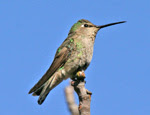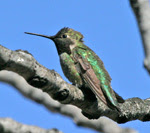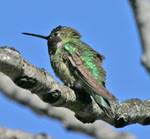



We have one species of hummingbird (Anna’s, Calypte anna) that stays with us year-round, and the male of that species is the star of our springtime mating plumage show. I took photos this morning of this single male perching in our fig tree (yes, we have deciduous trees in Southern California!). He just happened to be the only one brave or foolish enough to get close to me and my camera; I’d estimate we have between 40 and 50 pairs of Anna’s hummingbirds visiting our feeders daily. The males are extraordinarily showy when they directly face you (as you can see in the rightmost photo); when even slighly off-angle much of the color disappears.
As usual, click on the small pictures for a larger view…
I’ve never found a nest for an Anna’s hummingbird, even though they are by far the most common hummingbird here. When walking in the chaparral, at any time of year, the chances are very high that any hummingbirds you see (at least in our area) are Anna’s. I’ve searched through brush in the springtime near where I see them perch, but have never managed to spot a nest. I have found two black-chinned hummingbird nests, both in the dead wood of manzanitas on the edge of a clearing — easy to spot.

Perched on the feeder at right is (I believe) a juvenile male Anna’s. His colors are a bit off because of the reflected red light from the feeder, and the reflected green light from the transparent “hummer juice” container on the feeder. If you look at the larger version of that picture, you’ll see it’s very detailed (and even that was reduced for reproduction on the web). That’s what you get when you’re 7 feet from the bird with a high-powered telephoto! On the left is a female hummingbird, and these are notoriously difficult to identify. I believe this is a juvenile female Anna’s, however. The adult female Anna’s have a surprising amount of bright red color on their throats, especially in the springtime.

Finally there are these two shots of a black-chinned hummingbird (Archilochus alexandri), an adult male. This species leaves each winter and returns each spring. The “black-chinned” name is a bit misleading; if you catch these fellows just right (which I didn’t in these pictures), they have a brilliant, very saturated purple patch on about the lower two-thirds of that black chin. While they are not the showiest hummer here, I think they are actually the most beautiful of the four commons species here, when you catch them just right. He’s looking a little disheveled here, but that’s only because he spent 15 minutes in our bird bath just prior to perching on our fig tree to dry out. The black-chinned hummers appear to be the smallest of our hummingbirds, though Sibley says they’re about average (3.75” long). The males have a spectacular diving loop display, which they will repeat endlessly during the spring seasons. They tend to use the same spot over and over; if you go lie on the ground under where one is displaying the effect is quite dramatic. The hummer will start out perhaps 60 or 70 feet high; a little speck flickering against the blue sky. Then suddenly he’ll dive straight down, straight at your face if you’re positioned well. Then just a few feet off the ground he’ll pull out of the dive, in a “U” shaped curve that ends up with him going straight up, just a few feet away from where he just went down. He makes some distinctive noises during this display that I won’t even try to describe. When I first saw this display, the spring after we moved out into the chaparral, I though the hummers were suicidal — they are moving fast, and it doesn’t look safe…
